#Mughal Indian design
Text

ROSETTE
“A rosette is a horizontal cross section of a flower,” notes Albright. Imagine a circular form viewed from above.
From Wikipedia:
In botany, a rosette is a circular arrangement of leaves or of structures resembling leaves. In flowering plants, rosettes usually sit near the soil. Their structure is an example of a modified stem in which the internode gaps between the leaves do not expand, so that all the leaves remain clustered tightly together and at a similar height.
Many plant families have varieties with rosette morphology; they are particularly common in Asteraceae (such as dandelions), Brassicaceae (such as cabbage), and Bromeliaceae.
#motif#rosette#floral motif#rug pattern#rug patterns#rug motifs#rug motif#persian design#Mughal Indian design#Mughal India#Mughal empire#turkish design#persian rug#turkish rug#modified stem#Asteraceae#Brassicaceae#Bromeliaceae
12 notes
·
View notes
Text

Brighton & Hove News, 28 July 2023:
'A Brighton family have literally stopped traffic with a new mural inspired by a sari pattern on their new home.
Poppy Jaman and Jaan Madan moved to Southampton Street in Hanover in January, and immediately knew they wanted to make a splash when decorating the outside.
She said: “One of the reasons we wanted to move to the centre of Brighton is that it’s so colourful.
“We were inspired by murals in Washington where there’s a whole area where there’s murals which have been created out of adversity.
“That inspired the idea of making a statement with our home. I wanted to not just paint something that I love. If you just love something that’s enough, but I also wanted to say here’s a bit of my identity.
“I collect saris and Jamdani is a signature saris of Bangladesh. It’s got a colonial past to it.

📷 X
The mural is inspired by the Jamdani weave saree, the signature saree of Dhaka, Bangladesh, which dates back at least as far back as 300BC.
Between the 16th and 19th centuries, Jamdani fabric – so fine it was known as ‘woven air’ – was one of the most highly coveted commodities in Mughal courts and further afield. However, by the mid-19th century, Jamdani had become almost extinct.
Poppy has written more about her relationship with the Jamdani design and its colonial history here.'
#sari#mural#brighton#mughal#textiles#textile history#jamdani#dhaka#bangladesh#colonial history#indian history#weave#woven fabric#pattern#surface pattern#surface pattern design#pattern design#textile design#surface decoration#street art#uk#england#british asian#saree#traditional crafts#traditional textiles#traditional clothing#bengali#weaving
136 notes
·
View notes
Note
My family sold all our heirloom jewelry decades ago too! :(
RAHHHH!!!!! no cuz literally what was the point of existing so long ago if u don't have snazzy shit 2 pass down 😮💨😒😤 relatives suck so bad.
#i have jewelry still it's really just the war stuff 👍 there were the old muskets too not just the swords#but it's diff i think bc that's the entire point of asia 😩 caste system stupid af but all those swords meant smth!!!!!#what was the point of the caste system if i didnt get my swords <- ☠️☠️☠️☠️ WHAT A CRAZY THING TO SAY AHHHH LMFAOHDJDNSKSH#but it's neat. esp when it overlaps w mughal history + u can see the (now arab) influences alongside indian in the designs#tragic.#anon#answered#on posts
3 notes
·
View notes
Text
The Ancient Art of Gold and Silver Embroidery
The Ancient Art of Gold and Silver Embroidery Explore the rich history and cultural significance of gold and silver embroidery, a revered art form that has been practiced for centuries. From the intricate designs of the Mughal Empire to the delicate fabrics of the Portuguese, this video takes you on a journey through the techniques, materials, and centers of gold and silver embroidery.
#Gold embroidery#silver embroidery#Zardozi#kalabattu#karchob#pasa#gold threads#silver threads#embroidery techniques#Indian embroidery#Mughal Empire#Portuguese embroidery#cultural significance#historical significance#liturgical vestments#Kerala#Christianity#embroidery stitches#couching stitch#satin stitch#chain stitch#stem stitch#running stitch.#indianfashion#sarees#clothing#style#dresses#designer#indianwear
0 notes
Text
NMACC showcase: From beetle wings to chintz, India’s gift to global fashion
Special commissions from Rahul Mishra
| Photo Credit:
Mitsun Soni
A little over 150 years ago, over 30,000 hand cut and mounted samples of Indian textiles were painstakingly organised into an album series to educate and inspire commercial and design industries in India and Britain. Its creator, John Forbes Watson, called them ‘trade museums’.
Watson would have been pleased to walk around the…
View On WordPress
#Alexander McQueen Plato’s Atlantis#Anamika Khanna#archival inspirations to contemporary times#armadillo boots#armadillo dress#Bollywood costumes#chanel#Chintz#curator Hamish Bowles#dior#Exhibition Design Director Patrick Kinmoth#Great Exhibition of London 1851#impact that India has had on western fashion#India in Fashion#Indian fashion#India’s impact on the global fashion#Metropolitan Museum#Mughal gardens#New York#nita ambani#nmacc#Rahul Mishra#Ritu Kumar#Sternocera ruficornis#the Royal Ontario Museum#yves saint laurent
0 notes
Text
Emerald Spectacles from India, c. 1620-1660 CE: the lenses of these spectacles were cut from a single 300-carat emerald, and it was believed that they possessed mystical properties

These eyeglasses are also known by the name "Astaneh-e ferdaws," meaning "Gate of Paradise," based on the symbolic associations between the color green and the concept of spiritual salvation/Paradise. That symbolism (which is rooted in Islamic tradition) was especially popular in Mughal-era India, where the spectacles were made.
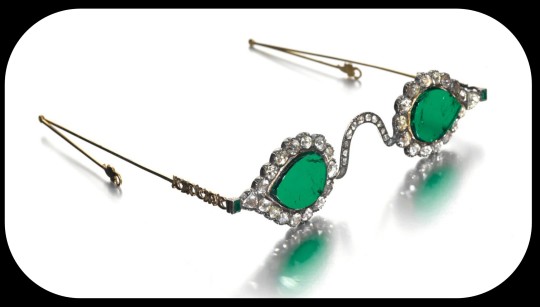
The lenses were crafted from two thin slices of the same emerald. Together, the lenses have a combined weight of about 27 carats, but given the precision, size, and shape of each lens, experts believe that the original emerald likely weighed in excess of 300 carats (more than sixty grams) before it was cleaved down in order to produce the lenses. The emerald was sourced from a mine in Muzo, Colombia, and it was then transported across the Atlantic by Spanish or Portuguese merchants.
Each lens is encircled by a series of rose-cut diamonds, which run along an ornate frame made of gold and silver. The diamond-studded frame was added in the 1890s, when the original prince-nez design was fitted with more modern frames.
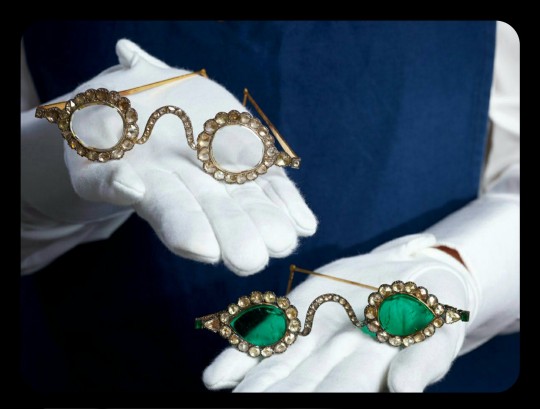
The emerald eyeglasses have long been paired with a second set of spectacles, and they were almost certainly commissioned by the same patron. This second pair is known as "Halqeh-e nur," or the "Halo of Light."
The Halo of Light features lenses that were made from slices of diamond. The diamond lenses were cleaved from a single stone, just like the emerald lenses, with the diamond itself being sourced from a mine in Southern India. It's estimated that the original, uncut diamond would have weighed about 200-300 carats, which would make it one of the largest uncut diamonds ever found.

The lenses are so clear and so smoothly cut that it sometimes looks like they're not even there.
Both sets of spectacles date back to the mid-1600s, and it's generally believed that they were commissioned by a Mughal emperor or prince. The identity of that person is still a bit of a mystery, but it has been widely speculated that the patron was Shah Jahan -- the Mughal ruler who famously commissioned the Taj Mahal after the death of his wife, Mumtaz Mahal. Shah Jahan did rule as the Mughal emperor from about 1628 to 1658.
The emerald and diamond lenses may have been chosen for symbolic, sentimental, and/or cultural reasons, or they may have been chosen simply because they're pretty and extravagant; the original meaning and purpose behind the design is still unclear. Experts do believe that the eyeglasses were designed to be worn by someone, though.
At times, it was believed that the spectacles had spiritual properties, like the ability to promote healing, to ward off evil, to impart wisdom, and to bring the wearer closer to enlightenment. Those beliefs are largely based on the spiritual significance that emeralds and diamonds can have within certain Indic and Islamic traditions -- emeralds may be viewed as an emblem of Paradise, salvation, healing, cleansing, and eternal life, while diamonds are similarly associated with enlightenment, wisdom, celestial light, and mysticism.
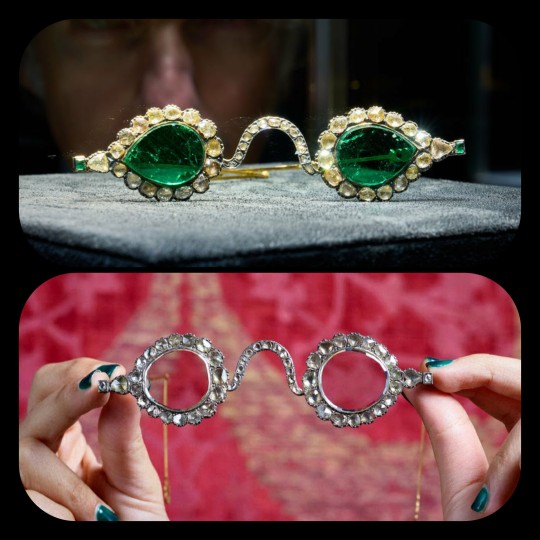
The Gate of Paradise and the Halo of Light were both kept in the collections of a wealthy Indian family until 1980, when they were sold to private collectors, and they were then put up for auction once again in 2021. They were most recently valued at about $2 million to $3.4 million per pair.
Sources & More Info:
Sotheby's: Mughal Spectacles
Architectural Digest of India: At Sotheby's auction, Mughal-era eyeglasses made of diamond and emerald create a stir
Only Natural Diamonds: Auspicious Sight & the Halqeh-e Nur Spectacles
The Royal Society Publishing: Cleaving the Halqeh-Ye Nur Diamonds
Gemological Institution of America: Two Antique Mughal Spectacles with Gemstone Lenses
Manuscript: From Satan's Crown to the Holy Grail: emeralds in myth, magic, and history
CNN: The $3.5 million Spectacles Said to Ward off Evil
BBC: Rare Mughal Era Spectacles to be Auctioned by Sotheby's
#history#archaeology#artifact#mughal#india#17th century#art#emerald#diamond#glasses#indian lore#islam#religion#mysticism#indian history#anthropology#spirituality#fashion
5K notes
·
View notes
Text

Dagger with Scabbard
Indian, Mughal 1605–27
The hilt of the dagger is constructed of heavy sections of gold over an iron core and its scabbard mounts are of solid gold. All the intricately engraved surfaces are set with gems and colored glass finely cut with floral forms. The designs closely parallel those in Mughal painting of the early seventeenth century, suggesting the dagger dates from the reign of Emperor Jahangir (1605–27), whose deep love of nature, especially flowers, is well documented in his memoirs, the "Tuzuk." The blade is forged of watered steel.
823 notes
·
View notes
Text
book recs masterpost
an ever-updating masterpost of books i've recommended. please check these before you ask for recommendations in case they've been covered —
fiction
"the tragedy still happened, but it was important that the love was there"
japanese literature
korean literature [1], [2]
gothic writing
spooky adult horror gothic
some favourites
marathi books
some ruskin bond
indian fiction [1], [2], historical fiction, stories, [3], [4]
non-fiction
general assorted ones i like
some favourites
about people living through crises
on geopolitics, foreign policy, international affairs
on political philsophy
vaguely sociology
biographies
on economic history
on the silk route
on prisons, convict labour
on afghanistan, soviet invasion, terror
capitalism
on language and linguistics
on the ancient and prehistoric world
just a bunch on india
the indus valley
indian aestheticism, art
gupta empire
sangam literature
on the northeast
india and southeast asia
nur jahan, mughal women | more
islamic conquest and state-making
on kashmir
assorted nonfiction
colonisation and aftereffects
on nationalism
on cities
on mumbai
on bollywood in bombay
on cities
on delhi
on kolkata
essays
history, migration, labour
art, reading, travel, gender, sports
nature, climate, some history
political economy, environmental and urban history, cartography and space
my comfort books
light reading
books that have got me out of my slumps
on art, photography, aesthetics, design [1], [2], [3]
on the environment
just some story and essay collections
#booklr#masterpost#book recs#book blog#reading list#reading#essays#literature#academia#faq#gaaaandaaaalf#book list#historyblr
2K notes
·
View notes
Note
Can I request a bakugou x indian reader? (If you can do that!) Like him trying out the cuisine (not butter chicken and naan!), like, Pani puri, palak paneer, dal mahkni etc. him visiting all the mahals (tak mahal, hawa mahal), going to Varanasi ghats, etc? If you wanna that is!! No pressure!
(if you can't do this, can you just post this ask saying that you couldn't do it?)
Thank you!! Have a nice day/night!!
The summer sun bore down on the bustling streets of Jaipur, but Katsuki Bakugou barely noticed the heat. He was too focused on the excited glint in your eyes as you navigated the busy marketplace, guiding him through the sea of colors, sounds, and scents that overwhelmed his senses.
You had been planning this trip for months, eager to share a piece of your heritage with him. The initial resistance he showed had slowly melted away as he saw how much this meant to you. Now, he was here, ready to experience everything India had to offer—starting with the food.
"What's that?" Bakugou asked, eyeing a street vendor as they prepared something he had never seen before. You grinned, pulling him closer to the stall.
"Pani puri," you replied, watching his expression as the vendor filled the small, hollow puris with spicy tamarind water and potatoes. "It’s a popular street snack. You’re supposed to eat it in one bite."
Bakugou raised an eyebrow but didn’t back down. He took one puri, mimicking your actions as you showed him how to eat it properly. The moment it burst in his mouth, a rush of flavors hit him—spicy, tangy, a little sweet—all at once. It was a sensory overload, but not in a bad way.
"Not bad," he said after swallowing, his usual gruff tone softened by the appreciation for the unfamiliar flavors. "Could use a little more heat, though."
You laughed, knowing how much he loved spicy food. "Of course, you’d say that. But don’t worry, there’s plenty more for you to try."
The two of you spent the rest of the day exploring Jaipur, stopping every now and then to try another dish. You introduced him to palak paneer, a creamy spinach dish with cubes of soft paneer cheese, and dal makhani, a rich lentil stew that made even Bakugou pause as he savored the complex flavors. He grumbled about how different it was from the food back home, but you could tell he was enjoying himself.
Afterwards, you visited the Hawa Mahal, the iconic palace with its intricate pink façade. As you walked through its corridors, Bakugou marveled at the architecture—though he’d never admit it out loud. You pointed out the small windows, explaining how the royal women would watch the bustling streets below without being seen themselves.
"Kind of a weird design," he remarked, looking out at the city from one of the windows. "But it’s not bad."
You smiled, knowing that was probably the closest he’d get to admitting he found it impressive.
The next stop was the Taj Mahal. Even someone like Bakugou, who usually dismissed grand gestures, couldn’t help but be in awe of the sheer beauty of the mausoleum. The white marble seemed to glow under the sun, and the symmetry of the architecture was breathtaking. You told him the story behind it, how the Mughal emperor Shah Jahan built it in memory of his beloved wife.
"That’s one hell of a way to honor someone," he said, his voice uncharacteristically soft as he looked up at the monument.
You nodded, watching his expression as he took it all in. It was moments like these that made you grateful to have him by your side. He might not always say the right things, but his actions showed how much he cared—how much he wanted to understand your world.
After the Taj Mahal, the two of you made your way to Varanasi, one of the oldest cities in the world. The ghats along the Ganges River were bustling with activity, and Bakugou watched in silent curiosity as people performed rituals, offering flowers and prayers to the sacred river.
"Why do they do that?" he asked, his voice low as he observed the scene before him.
You explained the significance of the Ganges, how it was believed to cleanse sins and how people came from all over India to bathe in its waters. You could see the gears turning in his head, trying to make sense of it all in his own way.
As the sun set, the two of you joined the crowd for the evening Aarti ceremony. The air was thick with the scent of incense, and the sound of bells and chanting filled the air. Bakugou stood close to you, his usually stern expression softened by the ethereal beauty of the ceremony. The flickering flames, the devotion in the air—it was all so different from anything he had ever experienced, and yet, he found himself drawn to it.
When the ceremony ended, you turned to him, wondering what he thought. He didn’t say anything at first, just looked at you with an intensity that made your heart skip a beat.
"You really love this place, don’t you?" he finally said, his voice uncharacteristically gentle.
You nodded, feeling a lump in your throat. "Yeah, I do."
He didn’t say anything else, just took your hand in his, giving it a reassuring squeeze. In that moment, you knew that he understood. He might not have the words to express it, but he was here, sharing this experience with you—and that was enough.
The rest of your trip was a whirlwind of experiences. You visited more temples, explored bustling markets, and sampled every kind of street food you could find. Bakugou’s initial hesitance melted away as he threw himself into the experience, trying everything you suggested with an open mind. You even caught him smiling more than once, though he’d deny it if you ever brought it up.
On your last day, the two of you found yourselves back in Varanasi, sitting by the ghats as the sun set over the Ganges. The air was cooler now, and a sense of peace settled over the city as the day came to a close.
"Thanks for bringing me here," Bakugou said suddenly, breaking the comfortable silence. "It’s…different from what I’m used to, but I’m glad I came."
You smiled, leaning your head on his shoulder. "I’m glad you came too. It wouldn’t have been the same without you."
He grunted in response, but you knew him well enough to recognize the affection behind the sound. The two of you sat there in silence, watching as the last rays of sunlight faded away, leaving the city bathed in the soft glow of twilight.
In that moment, you knew that this trip would stay with you forever—a memory of a shared experience that brought the two of you even closer together. No matter where your adventures took you next, you knew you’d always carry a piece of India with you—and you were grateful to have shared it with him.
Requests are open.
#bakugou x reader#katsuki bakugou x reader#bakugo katsuki x reader#katsuki x you#bakugou katuski x reader#bakugo x reader#bakugou x you#bakugou katsuki x reader#katsuki bakugo x reader#bakugo x you#katsuki x reader#x reader#fanfic#fanfiction#bakugou x y/n#katsuki x y/n#katsuki bakugo x y/n#mha fanfiction#reader insert#mha x reader#my hero academia x reader
39 notes
·
View notes
Text
A walk through Bengal's architecture
Bengali architecture has a long and rich history, fusing indigenous elements from the Indian subcontinent with influences from other areas of the world. Present-day Bengal architecture includes the nation of Bangladesh as well as the Indian states of West Bengal, Tripura, and Assam's Barak Valley. West Bengal’s architecture is an amalgamation of ancient urban architecture, religious architecture, rural vernacular architecture, colonial townhouses and country houses, and modern urban styles. Bengal architecture is the architecture of Wind, Water, and Clay. The Pala Empire (750–1120), which was founded in Bengal and was the final Buddhist imperial force on the Indian subcontinent, saw the apex of ancient Bengali architecture. The majority of donations went to Buddhist stupas, temples, and viharas. Southeast Asian and Tibetan architecture was influenced by Pala architecture. The Grand Vihara of Somapura, which is now a UNESCO World Heritage Site, was the most well-known structure erected by the Pala rulers.

The Grand Vihara of Somapura
According to historians, the builders of Angkor Wat in Cambodia may have taken inspiration from Somapura. Bengal architecture became known for its use of terracotta due to the scarcity of stone in the area. Clay from the Bengal Delta was used to make bricks.
The temple architecture has distinct features like the rich wall decoration, often known as the terracotta temples, which was one of the remarkable elements of Bengali temple architecture. The double-roofed architecture of thatched huts was replicated by Bengali temples. Square platforms were used to construct the temples. Burnt brick panels with figures in geometric patterns or substantial sculptural compositions served as the temples' adornment.

Dochala style
These served as models for many temples that were built in undivided Bengal. Construction materials used in ancient times included wood and bamboo. Bengal has alluvial soil, so there isn't a lot of stone there. The bricks that were utilized to build the architectural components were made from stone, wood, black salt, and granite. Bengal has two different types of temples: the Rekha type, which is smooth or ridged curvilinear, and the Bhadra form, which has horizontal tiers that gradually get smaller and is made up of the amalaka sila. Mughal architecture, including forts, havelis, gardens, caravanserais, hammams, and fountains, spread throughout the area during the Mughal era in Bengal. Mosques built by the Mughals in Bengal also took on a distinctive regional look. The two major centers of Mughal architecture were Dhaka and Murshidabad. The do-chala roof custom from North India was imitated by the Mughals.

Jorasako thakurbari
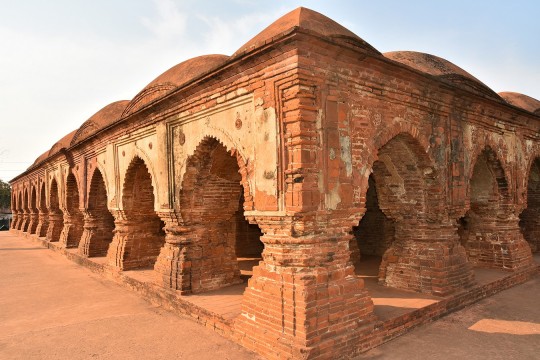
The Rasmancha is a heritage building located at Bishnupur, Bankura district, West Bengal.
Influence of the world on Bengal architecture: Although the Indo-Saracenic architectural style predominated in the area, Neo-Classical buildings from Europe were also present, particularly in or close to trading centers. While the majority of country estates had a stately country house, Calcutta, Dacca, Panam, and Chittagong all had extensive 19th and early 20th-century urban architecture that was equivalent to that of London, Sydney, or other British Empire towns. Calcutta experienced the onset of art deco in the 1930s. Indo-Saracenic architecture can be seen in Ahsan Manzil and Curzon Hall in Dhaka, Chittagong Court Building in Chittagong, and Hazarduari Palace in Murshidabad.
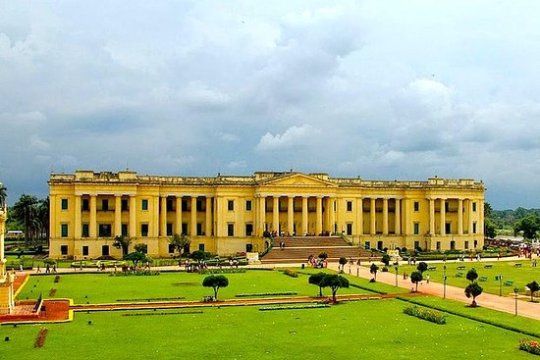
Hazarduari Palace in Murshidabad
The Victoria Memorial in Kolkata, designed by Vincent Esch also has Indo-Saracenic features, possibly inspired by the Taj Mahal. Additionally, Kolkata's bungalows, which are being demolished to make way for high-rise structures, have elements of art deco. The 1950s in Chittagong saw a continuation of Art Deco influences. The Bengali modernist movement, spearheaded by Muzharul Islam, was centered in East Pakistan. In the 1960s, many well-known international architects, such as Louis Kahn, Richard Neutra, Stanley Tigerman, Paul Rudolph, Robert Boughey, and Konstantinos Doxiadis, worked in the area.

The Jatiyo Sangshad Bhaban
This iconic piece of contemporary Bangladeshi architecture, was created by Louis Kahn. Midsized skyscrapers dominate the cityscapes of contemporary Bengali cities, which are frequently referred to as "concrete jungles." With well-known architects like Rafiq Azam, architecture services play a key role in the urban economies of the area. Overall Bengal architecture was influenced by various contemporaries of their time and continues to evolve.

Gothic architectural style seen in St. Paul's Cathedral in Kolkata.

Zamindar era buildings in ruin.

Belur Math in Howrah
#bengali#bangla#west bengal#bangladesh#tripura#assam#desi#বাংলা#india#architecture#tales#bengal architecture#history#kolkata#international#technology#information#temple#asia#bricks
183 notes
·
View notes
Text
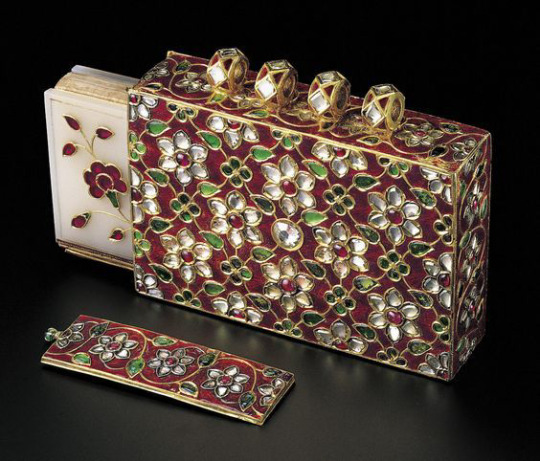
THE HOLY QUR’AN (India, Mughal Empire, 16th - 19th centuries)
This miniature book has a white nephrite cover inlaid with gold and set with rubies and emeralds. The case, designed as a pendant, is enamelled with champleve and set with diamonds, rubies and emeralds.
The Mughal Empire was important for bringing together almost the entire Indian subcontinent under one domain. It was known for its cultural influence and its architectural achievements —most famously, the Taj Mahal.
#beautiful books#book blog#books books books#book cover#books#holy quran#islamic#treasure binding#book binding#pendant#miniature books
193 notes
·
View notes
Text
The Sign of Four: The Strange Story of Jonathan Small (Part One of Two)
I will split this in two parts as I've got a lot to cover here.
CW for discussions of nasty prison conditions.
The depth of the Thames is about 6.5 metres at low tide in Woolwich, near to the Plumstead Marshes as they were then. However, the river has strong currents and very little visibility, so it would be a risky operation even with 2024 diving technology for some rather small objects.
The rupee originally was a silver coin dating back to ancient times in India, becoming something of a standard currency during the Mughal period. The East India Company introduced paper rupees and while there was an attempt by the British to move their territory to the pound sterling, they soon gave up, minting their own rupees with the British monarch's head on. The currency was also non-decimal. India retained the currency post-independence and went decimal as well.
Mangrove trees are very common in equatorial coastline regions - they can remove salt from the water, which would kill many other trees.
Prisoners set to the Andaman Islands penal colony were forced to work nine to ten hours a day to construct the new settlement, while in chains. Cuts from poisonous plants and friction ulcers from the chains would often get infected, resulting in death.
The convict huts on Ross Island were two-storey affairs, with the bottom as a kitchen and took area, the prisoners sleeping on the upper floor. Designed this way as an anti-malaria measure, they however leaked and the prisoners themselves were constantly damp from the rainfall, offering them little protection from the mosquitoes in any event.
Ague is an obsolete term for malaria; adults experience chills and fever in cycles.
The British would conduct experiments with quinine as a malaria treatment by force-feeding it to the prisoners. This caused severe side effects.
The British would make use of locals as warders, who wore sashes and carried canes. I'd imagine they could probably be quite brutal.
Pershoe is a small town on the River Avon near Worcester. It has a railway station with an hourly service to London, taking just under two hours today.
"Chapel-going" in this context means that the people attended a non-conformist church i.e. not one part of the Church of England.
"Taking the Queen's/King's shilling" was a historical term for joining the armed forces - for the army this was officially voluntary, but sailors could be forcibly recruited, being known as "press-ganged" until 1815. You would be given the shilling upon initial enlistment or tricked into taking it via it being slipped into your opaque beer. You would return the shilling on your formal attestation and then receive a bounty which could be pretty substantial in terms of the average wage, although a good amount of that would then be spent on your uniform. Some enlisted, deserted and then reenlisted multiple times to get multiple payments. The practice officially stopped in 1879, but the slang term remains.
The 3rd Buffs refers to the latter 3rd Battalion, Buffs (East Kent Regiment), a militia battalion that existed from 1760 to 1953, although it effectively was finished in 1919. However, in reality, they did not go to India to deal with the rebellion, instead staying in Great Britain to cover for the regular regiments who did.
The British never formally adopted the Prussian "goose step" instead going for the similar, but less high-kicking, slow march.
The musket would possibly have been the muzzle-loaded Enfield P53, a mass-produced weapon developed at the Royal Small Arms Factory in Enfield. It was itself was the trigger of the Indian Rebellion in 1857 due to the grease used in the cartridges. They would also be heavily used in the American Civil War on both sides, especially the Confederate one as they smuggled a lot of them, with only the Springfield Model 1861 being more widely used. As a result, they are highly sought after by re-enactors. The British used them until 1867, when they switched to the breech-loading Snider-Enfield, many of the P53s being converted.
The crocodile would likely have been a gharial, which mainly eat fish. Hunting and loss of habitat has reduced their numbers massively, with the species considered "Critically Endangered" by the IUCN.
"Coolie" is a term today considered offensive that was used to describe low-wage Indian or Chinese labourers who were sent around the world, basically to replace emancipated slaves. Indentured labourers, basically - something the US banned (except as a riminal punishment) along with slavery in 1865. In theory they were volunteers on a contract with rights and wages, however abuses were rife. Indentured labour would finally be banned in British colonies in 1917.
Indigo is a natural dark blue dye extracted from plants of the Indigofera genus; India produced a lot of it. Today, the dye (which makes blue jeans blue) is mostly produced synthetically.
I have covered the "Indian Mutiny" as the British called it here in my post on "The Crooked Man".
The Agra Fort dates back to 1530 and at 94 acres, it was pretty huge by any standards. Today, much of it is open to tourists (foreigners pay 650 rupees, Indians 50), although there are parts that remain in use by the Indian Army and are not for public access.
"Rajah" meaning king, referred to the many local Hindu monarchs in the Indian subcontinent; there were also Maharajahs or "great kings", who the British promoted loyal rajahs to the rank of. The Muslim equivalent was Nawab. However, a variety of other terms existed. The East India Company and the Raj that succeeded them used these local rulers to rule about a half their territory and a third of the population indirectly, albeit under quite a bit of influence from colonial officials. These rulers were vassals to the British monarch; they would collect taxes and enforce justice locally, although many of the states were pretty small (a handful of towns in some cases) and so they contracted this out to the British. As long as they remained loyal, they could get away with nearly anything.
562 of these rulers were present at the time of Indian independence in 1947. Effectively abandoned by the British (Louis Mountbatten, the last Viceroy, sending out contradictory messages), nearly all of them were persuaded to accede to the new India, where the nationalists were not keen on them, with promises they could keep their autonomy if they joined, but if not, India would not help them with any rebellions. Hyderabad, the wealthiest of the states, resisted and was annexed by force. The ruler of Jammu and Kashmir joined India in exchange for support against invading Pakistani forces, resulting in a war. A ceasefire agreement was reached at the beginning of 1949, with India controlling about two-thirds of the territory; the ceasefire line, with minor adjustments after two further wars in 1965 and 1971, would become known as the Line of Control, a dotted line on the map that is the de facto border and one of the tensest disputed frontiers on the planet.
India and Pakistan initially allowed the princely rulers to retain their autonomy, but this ended in 1956. In 1971 and 1972 respectively, their remaining powers and government funding were abolished.
Many of the former rulers ended up in a much humbler position, others retained strong local influence and a lot of wealth. The Nizam of Hyderbad, Mir Osman Ali Khan was allowed to keep his personal wealth and title after the annexation in 1948 - he had been the richest man in the world during his rule and used a 184-carat diamond as a paperweight, at least until he realised its actual value. The current "pretender", Azhmet Jah, has worked as a cameraman and filmmaker in Hollywood, including with Steven Spielberg.
15 notes
·
View notes
Note
i just a saw a person design a hijra pride flag with a baby pink stripe on top, a baby blue stripe at the bottom and then there was a super thin red stripe in the very middle surrounded by two thinner white stripes. the thin red stripe stood for "the divinity blessed by lord rama" and 😐 i guess people decided to forget that muslim hijras exist and were considered pretty important during the mughal raj and they are an important part of (indian) history. i hate it here [yeah the pink, blue & white stripes have the same meaning as the trans flag 🏳️⚧️]
what.
19 notes
·
View notes
Text
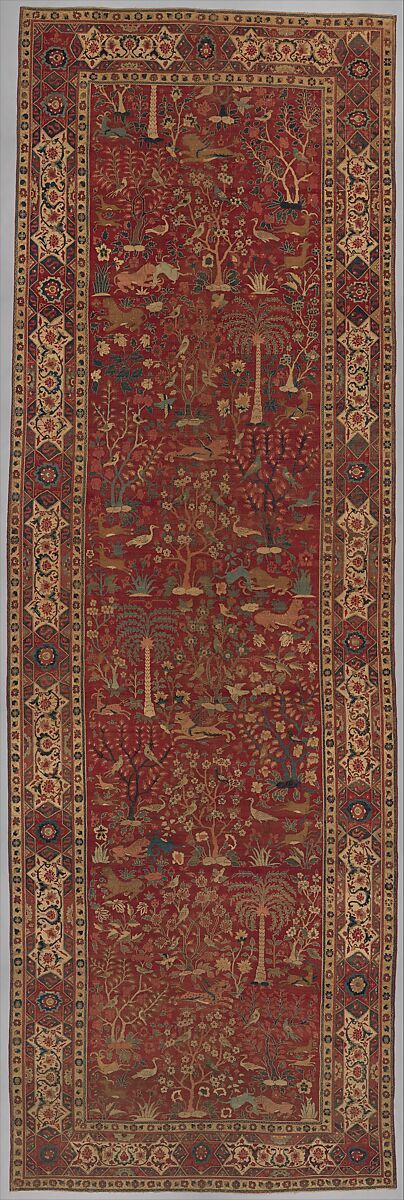
Carpet with Palm Trees, Ibexes, and Birds
Probably made in present-day Pakistan, Lahore, late 16th–early 17th century
Cotton (warp and weft), wool (pile); asymmetrically knotted pile
This carpet, with its pictorial depiction of trees, birds, and animals, is conceived like a textile with a repeat design in which each unit reverses the direction of the preceding one. The ibexes, Chinese mythological beasts called qilins, and animals in combat, are derived from Safavid Persian art, as is the border design of cartouches and star-shaped medallions with cloud bands. The palm tree, however, is a very Indian feature, as is the generally naturalistic drawing of the flora and fauna and the bright red color of the field. The relationship to Persian carpet design dates this example to the early Mughal period, soon after the first carpet workshops were established by the emperor Akbar in Lahore, Agra, and Fatehpur Sikri.
Although the advent of carpet weaving in India predates his reign, it was the Mughal emperor Akbar (r. 1556–1605) who established imperial workshops for carpets, as well as a pattern of royal patronage. Carpet workshops were set up first at Fatehpur Sikri, the imperial capital only from 1571 to 1585, then at Lahore and Agra, and then, before 1640, at Kashmir.[1] Not all Indian carpets surviving from these early times necessarily suggest imperial manufacture, so commercial workshops must also have been in full production. Masters and workmen, many undoubtedly Iranian, are known to have come to India to help establish the workshops, and Persian carpets also clearly continued to be imported despite the high quality of local production.[2]
It should not be surprising, then, that this large carpet, representing production dating from late in the reign of Akbar, displays strong Persian influence. The most popular Persian convention was the symmetrical arrangement of scrolling vines with blossoms and leaves, but another approach was the use of pictorial patterns similar to those produced for paintings in royal manuscripts (the two conventions are combined in some examples). The field pattern here combines animals, birds, and vegetation in a pictorial way, that is, they are meant to be seen from one direction and without the matrix of a vine-scroll pattern to connect everything. Pictorial designs can be found in Persian carpets in a few examples of the small "Kashan" rugs and even more in a couple of pieces of the "Sanguszko" group; direct contact of some sort is also implied by the use of certain colors. Counterparts of several animals represented here may be seen in one of the Museum’s Persian rugs (no. 14.40.721), notably the leaping ibex, the combat between lion and ibex, and the leaping lion. Flames at the shoulders, indicating supernatural qualities, betray the ultimate Chinese origin of some of these figures, as transmitted to Iran in preceding centuries.
In many respects, however, this carpet is unmistakably Indian. In terms of structure, the cotton warps are eight-ply instead of the four-ply typically found in Persian carpets. As for color, the palette has a brightness, especially in the red, lacking in most Persian pieces, and there is a heavy use of ton-sur-ton coloring, juxtaposing similar colors such as red and pink, light and dark blue, and ocher and beige or off-white. The interlocking compartment design of the main border is related to borders found in Persian carpets (see MMA no. 1978.550), but here it takes a particularly Indian form in its geometricized compartments and the particular silhouette effect of the un-outlined red palmettes and vines set against the white ground. And the palm trees strike an Indian chord. As large as this carpet is, far larger ones are known to have come from Indian looms, including a pair of mid-seventeenth-century audience carpets, each about sixty-three feet long (approximately 19 meters).[3]
Daniel Walker in [Ekhtiar, Soucek, Canby, and Haidar 2011]
Footnotes:
1. Walker, Daniel. Flowers Underfoot: Indian Carpets of the Mughal Era. Exhibition catalogue, Metropolitan Museum, New York, 1997, pp. 7, 12.
2. Abu’l Fazl ‘Allami. The A’in-i Akbari by Abu’l Fazl ‘Allami. Translated by H[enry F.] Blochmann and H[enry] S. Jarrett; edited by D[ouglas] C[raven] Phillott. 3rd ed. 3 vols. 1927–49. Calcutta, 1977, vol. 1, p. 57.
3. Walker 1997 (see note 1), p. 120, fig. 118.
#carpet#palm#trees#ibex#birds#Pakistan#lahore#India#16th century#17th century#cotton#wool#Mughal#history#akbar#Daniel walker#long post#artifacts
9 notes
·
View notes
Note
hey jalebi what’s like a headcanon you have for characters on ipkknd that wasn’t shown on the show, it could be things like hobbies, education, personality traits, special interests; i always thought that khushi may have a little bit of formal kathak training depending on what the guptas could afford
Hello hello!
This is a fun question so I'll answer this for Arnav & Khushi :)

Hobbies
Running (not just for fitness, running gives him the escape he needs from his head sometimes, a sense of total freedom), Chess (he was good enough to participate inter-college) Reading (anything about society - I like to believe his sense of detachment from the world comes from a dark yet honest perspective of what the world is), Note collector (would want to collect a note from every single country ever - one of the few childhood hobbies that he still pursues apart from gardening), Photography (it's something that helped me in his career as well but I do think he has an eye for visual design, and the photowall in his bedroom? That's his pictures from traveling), Traveling (his favorite hobby of all time - definitely the guy to travel to some remote place and stay there for a week upon his whim), Design (we never see him designing but I do think he's a designer as well and his designs would've been similar to Manish Malhotras - clean, sharp, rich)
Education
Nothing to head canon here :)
Personality Trait
More than personality I have a head canon for his childhood. He never saw his father around much. He was out for 'travels'. Arnav wasn't ever close to any male figure growing up and was very protective, rather than close, to his mother and sister. High chance his childhood was very troubled as well - even though he danced and was trauma free (hence happier).
Also Arnav is GENUINELY a loner - NOT quiet out of trauma. He loves his lone time, gets exhausted in crowd, and is happier around his plants. In fact even in his own fashion show he's done with it in like 3 minutes. He gave his speech, the walks are going, that's it - he'd rather close his eyes and take a minute to breath.
Arnav does not do well with a lot of people. Yes, where he needs to stand out he will. But, he would actually just do a lot better alone.
Special Interest
Bugs are interesting. It ties into his interest in gardening.

Hobbies
Sparkle collector (she's like a little magpie, anything shiny is stored in it) DIY (pillow covers, pompoms, suitcase decor - she'll constantly DIY something or the other) painting (she loves doing little floral paintings and historical ones - imagine that she is influenced by Mughal style paintings) history buff (limited to Indian history, but not enough of socio-politico knowledge you know).
Education
Government school - she never went to college, but learned a LOT of finance and accounting from running Shashi's sweet shop (high chance Khushi was already getting inquiries for marriage so she would've been married off younger than Payal)
Personality Trait
Khushi is a compulsive liar. From harmless lies to serious ones. And she is extremely prejudiced. She does crave attention - she has a lot of loud lonely child traits. She's "loved" but not quite unconditionally. Arnav is loved far more, his sense of belonging is far stronger with his family than Khushi's. But she's also quite ordinary. And that's... beautiful.
Her heart though, is graciously beautiful and she has a GREAT desire for learning. Also she's incredibly ready to adapt. If there's anyone who can weather a storm, it's actually her. Cause the common grass does not get uprooted - the tree does.
Special Interest
She's ALSO a huge SRK fan. Ok.
Best,
Jalebi
17 notes
·
View notes
Text
my deck arrived today and i wanted to show off how hypnotic the foil is because i feel like the pictures don't do it justice.
the mirror oracle was designed and fully illustrated by amrit brar (@musterniillustrates), published by 13th press. it serves as a companion to the marigold tarot.
from the guidebook, amrit writes: "life and death are recurring themes in this deck. the artwork, specifically the borders, take a great deal of inspiration from Indian and Mughal miniature painting. the rock pigeon and its skeleton frame the border of every card, mirrored to one another and surrounded by foliage. they reinforce the cycle of life and death as it repeats into eternity, through every experience, emotion, or plight depicted in the cards."
#the deck is so beautiful#and i am so proud of her#the marigold tarot#the mirror oracle#amrit brar#13th press#musterniillustrates#tarot#witchblr#oracle
10 notes
·
View notes